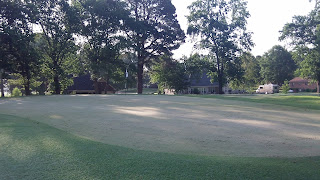The greens have good irrigation coverage, but no amount of irrigation water will take the place of a good rain shower. The greens were beginning to show signs of drought and heat stress a few weeks ago. I was irrigating as much as possible, but there were still areas of the greens that remained dry. I decided to punch some holes into the surface of the greens to provide channels for air and water movement.
We first used needle tines. These tines worked great and I liked the results, but they kept breaking. We used 40 tines on four greens.... a waste of time and money with those tines. I needed another option.
We first used needle tines. These tines worked great and I liked the results, but they kept breaking. We used 40 tines on four greens.... a waste of time and money with those tines. I needed another option.
Here are the results of the needle tines:
I decided to try some 0.25" solid tines instead of the needle tines. These tines were much stronger and we were able to finish the rest of the greens without a single failure.
Solid 0.25" Tines:
 The big questions is... Did I get the results I was after? Yes, I think that the greens responded great to the solid tine aeification. We had four days of 100+ degree weather with a low humidity and southern winds. The greens took water easily and I had very few dry spots. The other concern I had and I know golfers had... Was there a negative effect on ball roll? Yes, the greens were bumpy for about 5 days. I did notice that the ball still rolled true, but it did bounce a little on the way to the hole. I think that putting was only hindered for those few days and I did not notice any drop in green speed. I think that is a small price to pay for the added benefits of air and water movement into the the soil profile.
The big questions is... Did I get the results I was after? Yes, I think that the greens responded great to the solid tine aeification. We had four days of 100+ degree weather with a low humidity and southern winds. The greens took water easily and I had very few dry spots. The other concern I had and I know golfers had... Was there a negative effect on ball roll? Yes, the greens were bumpy for about 5 days. I did notice that the ball still rolled true, but it did bounce a little on the way to the hole. I think that putting was only hindered for those few days and I did not notice any drop in green speed. I think that is a small price to pay for the added benefits of air and water movement into the the soil profile.







